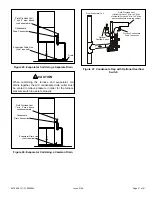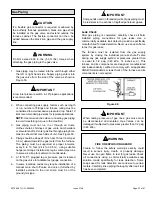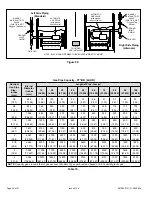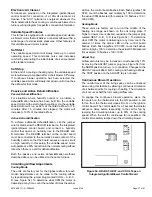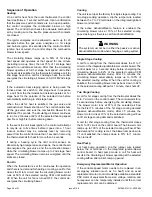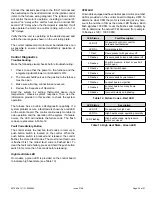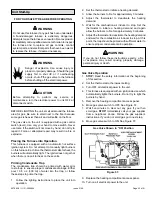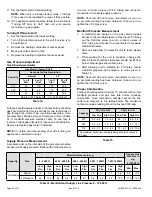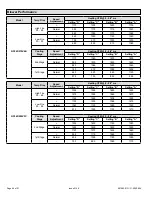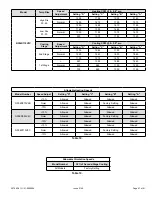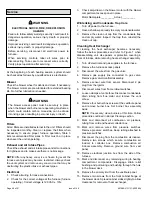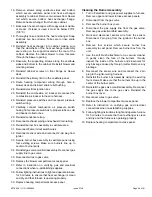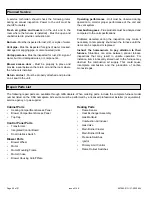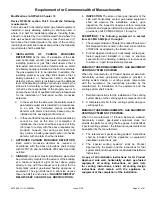
507962-01G / 31-5000654
Page 45 of 51
Issue 2149
Capacity
Natural to LP/
Propane
High Altitude Natural
Burner Orifice Kit
High Altitude LP/
Propane Burner
Orifice Kit
High Altitude Pressure Switch
0 - 7500 ft
(0 - 2286m)
7501 - 10000 ft
(2286 - 3048m)
7501 - 10000 ft
(2286 - 3048m)
4501 - 7500 ft
(1371 - 2286m)
7501 - 10000 ft
(2286 - 3048m)
070
11K48
*51W01
11K47
14A55
14A56
090
14A54
14A53
110
14A46
14A51
*Conversion requires installation of a gas valve manifold spring which is provided with the gas conversion kit.
Pressure switch is factory set. No adjustment necessary. All models use the factory-installed pressure switch from 0-4500 feet (0-1371 m).
Table 17. Conversion Kit Fan Pressure Switch Requirements at Varying Altitudes
High Altitude Information
NOTE:
In Canada, certification for installations at
elevations over 4500 feet (1371 m) is the jurisdiction of
local authorities.
Units may be installed at altitudes up to 4,500 ft. above
sea level without manifold adjustment. Units installed
at altitude of 4,501 - 10,000 feet (1371 to 3048 m) may
require a pressure switch change which can be ordered
separately. Table 17 lists conversion kit and pressure
switch requirements at varying altitudes.
The combustion air pressure switch is factory-set and
requires no adjustment.
NOTE:
A natural to LP/propane gas changeover kit is
necessary to convert this unit. Refer to the changeover kit
installation instruction for the conversion procedure.
Other Unit Adjustments
Primary Limit
The primary limit is located on the heating compartment
vestibule panel. This limit is factory set and requires no
adjustment.
Flame Rollout Switches (Two)
These manually reset switches are located on the front of
the burner box. These limits are factory set and require no
adjustment.
Pressure Switches
The pressure switches are located in the heating
compartment on the cold end header box. These switches
check for proper combustion air inducer operation before
allowing ignition trial. The switches are factory set and
must not be adjusted.
Temperature Rise
After the furnace has been started and supply and return
air temperatures have been allowed to stabilize, check
the temperature rise. If necessary, adjust the blower
speed to maintain the temperature rise within the range
shown on the unit nameplate. See Table 18 for allowable
heating speeds. Increase the blower speed to decrease
the temperature. Decrease the blower speed to increase
the temperature rise. Failure to adjust the temperature rise
may cause erratic limit operation.
Fan Control
The fan ON time of 30 seconds is not adjustable. The fan
OFF delay (amount of time that the blower operates after
the heat demand has been satisfied) is 120 seconds and
is not adjustable.
Thermostat Heat Anticipation
Set the heat anticipator setting (if adjustable) according to
the amp draw listed on the wiring diagram that is attached
to the unit.
Electrical
1. Check all wiring for loose connections.
2. Check for the correct voltage at the furnace (with
furnace operating). Correct voltage is 120 VAC ± 10%.
3. Check amp–draw on the blower motor with the blower
compartment access panel in place.
Motor Nameplate__________Actual__________
Electronic Ignition
The integrated control has an added feature of an internal
Watchguard control. The feature serves as an automatic
reset device for integrated control lockout caused by
ignition failure. This type of lockout is usually due to low
gas line pressure. After one hour of continuous thermostat
demand for heat, the Watchguard will break and remake
thermostat demand to the furnace and automatically reset
the integrated control to begin the ignition sequence.
Exhaust and Air Intake Pipe
1.
Check exhaust and air intake connections for tightness
and to make sure there is no blockage.
2.
Is pressure switch closed? Obstructed exhaust pipe
will cause unit to shut off at pressure switch. Check
termination for blockages.
3. Obstructed pipe or termination may cause rollout
switches to open. Reset manual flame rollout switches
on burner box assembly if necessary.

